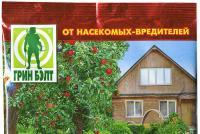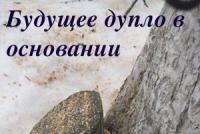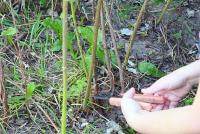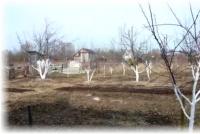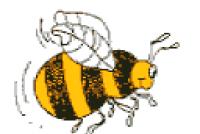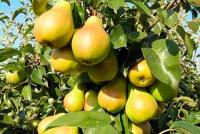How to save the apple tree from the nasty bloom
This is definitely a flower beetle - no doubt.
Pest description
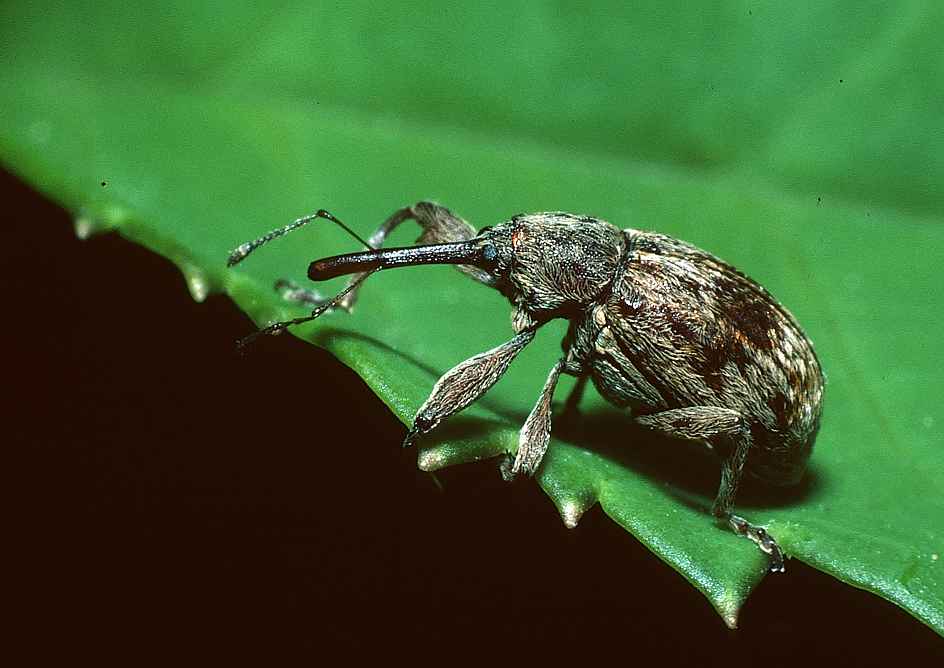
Flowerbird - a photo with a multiple increase
A lover of apple trees, pome fruit crops - Anthonomus pomorum L. - flower beetle (Apple weevil). Insect refers to the fruit weevils. Occupied the entire European territory of Russia, up to the Caucasus Mountains and the Urals. It is known about him and in Primorsky Krai. It is activated in the lean years unfavorable for farmers. The beetle is gray-brown or brown in color. Body shape, 3-5 mm long, oval-elongated. On the head is visible rostrum. The front wings cross two light stripes. During hibernation, it dwells in the bark of trees, hollows, under a pile of fallen leaves in a state of imago without sexual characteristics. Moreover, it feels comfortable in the home garden and in the forest plantings of wild pears and apple trees. Having warmed up to + 6 ° С, the air awakens weevils from hibernation, makes it creep into the tree crowns beginning to form. Emerging swelling buds become a source of food and insect development. An egg laid in a bud turns into a larva, which completely eats away the inside of the unblown flower. The remaining damaged flowers turn into inferior fruits of dwarf-sized or keratinous nodular growths.
On a note. If the struggle with the flower beetle on fruit trees is ignored, it is possible to lose 30% of their number even at the stage of formation of buds. Although there are cases when more than half of them are affected, or practically all buds, the potential harvest dies.
What does apple blossom eater prefer for lunch?
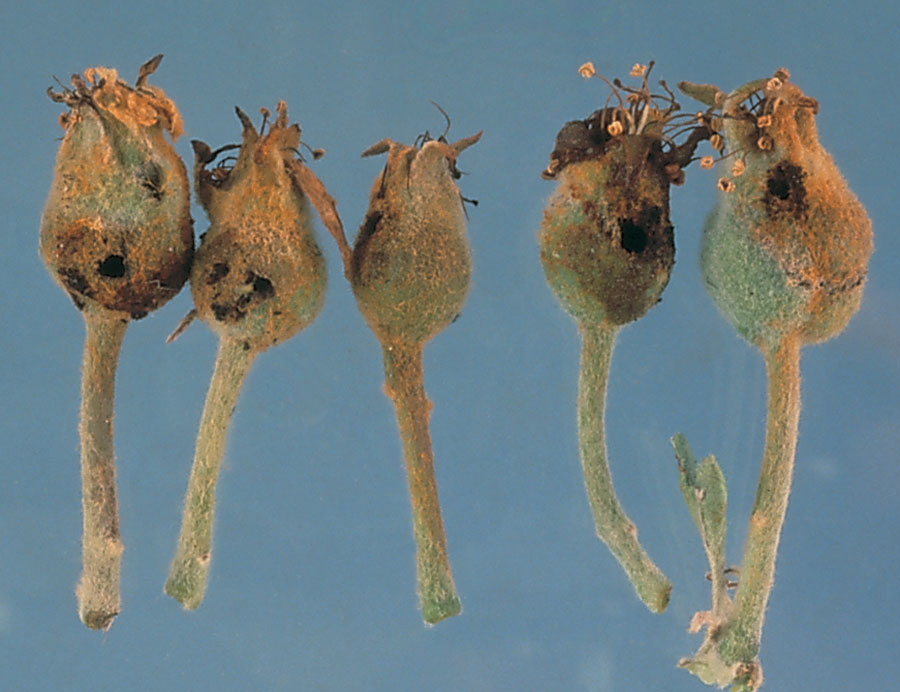
Look at the inflorescences - after flowering they look like
Preventive actions
The fight against weevils needs to start in the late autumn.
- The trunks of trees that have thrown off the leaves are cleared of the backward bark. A bare piece of wood is whitened with a lime mixture. Waste is carefully collected and incinerated.
- So do the fallen leaves, organic plant residues. Or the biological material is laid for rotting into the compost pit.
- The earth is dug up around the trees: the beetles hiding for the winter will freeze in the cold.

The most effective is the fight against apple bloom in spring.
- At the stage of awakening from hibernation and searching for food at a temperature of + 5- + 6 ° С, until the eggs inside the flower are laid, the shaking method is effective. Previously under the crown stretched polyethylene, oilcloth, tarpaulin. A mop with a wound rag knocks the trunk lightly. Sedentary beetles fall on the floor, from where they are swept and burned. Shaking is repeated at intervals of 1-2 days, until the trees are maximally free from beetles.
- It is possible in the upper part of the trunk, at the branching, to wind a bunch of hay or straw moistened with Carbofos.
- In the intermediate period, between the development of buds before blooming on the tree, in the lower part of it is made a shell made of thick cardboard, paper in the form of a belt 0.2 m wide. The belt is fastened with a string on a previously cleaned trunk. Non-drying epoxy resin is applied to the paper with a strip of 3-5 cm in width. Sticking insects every 1-2 days should be removed and destroyed.
- It is important to avoid laying eggs. It is difficult to do this on one individual site with the passive attitude of neighbors to the problem. An apple tree sprinkled with insecticide today, neighboring weevils will arrive tomorrow. Therefore, before treating apples from the flower beetle with toxic chemicals, until the buds have swollen, the tree is thoroughly sprayed with lime composition (dissolve 1.5 kg of lime in 10 liters of water). Dried white bloom scares insects: they do not sit on a tree and do not lay eggs.
- Twice in the spring (bare trees and with swollen buds) are treated with Decis: it is enough to dilute 10 ml of the preparation with a bucket of water. An alternative could be Fufanon, Karate, Fastak, Karbofos, Novaktion, Spark and other chemicals. In this line it is necessary to allocate means Calypso: destructive acting on beetles, it is not dangerous for bees.
In order to avoid getting used to the same drug, chemicals alternate in use.
Attention! The use of any reagent by a gardener is carried out in personal protective equipment. If it has not been used before, it is first tested on a single tree. Observation of planting lasts for a day. With positive dynamics, other trees are processed.

But, if, nevertheless, the flowering beetle on an apple tree has bred: how to fight? Dried, covered with brown bloom buds with larvae inside, break off, preventing the development of imago. Chemotherapy, unfortunately, is powerless over laid eggs and larvae hidden in the bud. It is recommended to re-spray the crops in July, while the surviving adult pests do not hide under the bark for the winter. Finding weevils in the green leaves in the summer, already with fruit, the treatment should be postponed, and the apples should be sprayed against the flowering beetle with the onset of autumn.
- Do not underestimate the effectiveness of the prepared formulations of plants. This is an infusion of tansy, tomato tops, tobacco. In terms of efficiency, they are inferior to chemicals that differ in the speed of damage. But, harmless to livestock, workers, bees, birds. For chamomile infusion will need 100-150 inflorescences. Flooded with 10 liters of water, they are aged 24 hours. After this, half a piece of laundry soap is added to the filtered composition.
- Garlic, onion and spruce tincture can be included in the traditional recipes. For this, the husks (cones, branches) are filled with water and left in a warm place for fermentation for 14 days. Strained liquid (1 l) is added to 10 l of water, sprayed once a week.
- A powerful deterrent is considered to be a decoction of wormwood. It is prepared from crushed dried plants (400 g) or 1 kg of fresh branches. Insist 24 hours, boil for 0.5 hours, add a third of the piece of laundry soap, strain, use as directed.
Not so scary, apple flowering bean, if you know how to deal with it correctly.

The beetle beetle is called the beetle family of the weevil brownish-gray color with oblique white stripes on the elytra, up to 0.45 cm in size, having an elongated head in a long proboscis. At the end of such a proboscis there is a special gnawing apparatus for feeding on leaves and buds. This gluttonous pest is widespread throughout the entire Nonchernozem zone. But it causes the greatest harm in the northern regions, where effective control of the flower beetle becomes especially necessary. It damages the pest of apples, pears and other fruit trees.
Adult beetles winter, hiding in bark cracks, under fallen leaves, or simply in the upper layers of the soil. With the first heat, the weevils begin to rise in the crowns and feed on the kidneys, eating out narrow indentations in them, very similar to needle pricks. Often on such kidneys can be observed drops of juice, speaking from wounds - "the kidneys are crying." With the beginning of the outcrop of the buds, the females of the flower beetle gnaw through holes in them and lay there in an egg — one in each bud. The larvae appear after 7 - 8 days and begin to eat the contents of the buds. Affected buds no longer bloom, and dry up, never opened. When it comes to the formation of ovaries, the larvae pupate directly in the damaged buds. Young insects come out during the shedding of excess ovaries and feed on the pulp of the leaves, eating away the “little windows”. In July and August, beetles no longer feed, but begin to climb under the bark, hiding under fallen leaves, in the soil - for wintering. During the season only one generation of flowering beetle develops.
A large number of dried buds remaining on the branches of an apple or pear tree testifies to the damage by a weevil. As well as the so-called “flower-eater huts” - glued petals of flowers, which dry quickly and form peculiar brown caps. If such a cap is lifted, there will be a larva of light yellow or white color, and sometimes a brown beetle.
Damage to fruit trees by the beetle is especially dangerous in cold springs, when the flowering of trees is delayed, as well as during the years when the apple blossoms are weak. In these cases, the apple flower beetle is able to destroy more than half of all buds, significantly reducing the yield.
Most other weevil damaged varieties with an average flowering period. In apple trees that bloom earlier, the most dangerous period for destruction is at a time when the beetles are not yet ready to lay eggs. And late blooming varieties - when the eggs are already laid. Particularly massive invasions of weevils occur in those gardens that are located close to forest belts or forests.
Damage prevention
Preventive measures against the defeat of plants by the flowering beast should be started long before the budding. First of all, you should clean the trunks of trees from the remnants of dead bark, which serves as a convenient place for wintering pests. This operation allows you to destroy a significant number of beetles, settled to wait out the cold season. But to do this cleaning should literally with the first warm days, otherwise the pest will have time to leave their shelters.
The next stage of preventive treatment will be whitewashing trunks. Both experts and amateur gardeners have noticed long ago that flower beetles are much less populated with fruit trees, which were whitewashed before the buds swell. To prepare the solution, take 2 kg of fresh lime on a bucket of water. But experienced gardeners sometimes deliberately leave one of the apple trees without whitewashing - to attract beetles and their subsequent destruction.
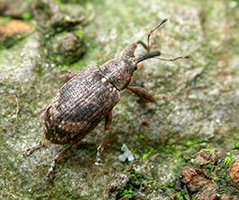 Just before flowering, glue traps are placed on the trunks, stopping the beetles trying to penetrate the treetops. After tying the fruit, these belts are removed to destroy.
Just before flowering, glue traps are placed on the trunks, stopping the beetles trying to penetrate the treetops. After tying the fruit, these belts are removed to destroy.
In the autumn it is necessary to collect and burn leaves fallen from the trees, dig up the soil in the garden. Sometimes they also use such a simple trick to combat the tsierouedom: around the shtambas, special heaps of leaves are laid out, attracting pests to hibernate, after some time they are burned along with the bugs that have gotten there.
Weevil control
At the time when the swelling and budding of the buds on the apple trees occur, it is very useful to shake off the beetles to a special bedding, which is placed under the crown. Wooden beaters or poles, wrapped with soft material to avoid damage to the bark, lightly hit the main branches of the tree. From the shaking, the beetles unhook and fall down on the litter, where they lie for some time, pretending to be dead. They are burned with litter or swept into a special container for destruction. Carry out such an operation should be at air temperature below 10 ° C, otherwise the beetles will have time to scatter.
In the case when after shaking off a tree there are 40 or more beetles, it is necessary to spray the plant with insecticides: Intavir, Kinmiks, or others intended to destroy leaf-eating insects. It can also be treated with Tanrek, which is not washable with water and acts in a wide temperature range. To combat the weevil, it is recommended to do one treatment per season.
If bugs are found in the crown in the summer, then the tree can be treated with toxic chemicals only in the fall. But this must be done, even with a small number of pests. One female tsveroyeda can lay up to hundreds of eggs, and when they are laid, no preparations will work on them. And next spring there will be much more pests in the garden, which will necessarily affect the quantity and quality of the crop.
Experts recommend the following chemicals for processing fruit against a weevil: Novaction, Fufanon, Fastak, Iskra, Sherpa, Karate. It helps very well to restrain the number of beetles, the drug Decis at a dilution of 10 ml per bucket of water. But if you use it only for several years in a row, then the pest will soon adapt to this poisonous substance and produce the same unresponsive offspring. Therefore, it is desirable to alternate all insecticides for at least one year. You can also use herbal extracts: pharmacy chamomile, tansy. Herbal remedies are much less effective than chemicals, but they are safe for animals, bees and other beneficial insects, do not pollute the soil and do not harm the environment.
The fight against tsvetoedom - not a simple matter, requiring temporary, labor and material costs. Therefore, it is important not to bring the garden to a critical state, but to engage in prevention, restraining the number of pests at the “safe” threshold.
indasad.ru
The most dangerous pests of apple trees, how to deal with them
It is unlikely that there will be such gardeners who have not been spoiled by the pests of apple trees. And it's good if the apples just lost their presentation, some insects can even leave a tree without fruit. It is not always possible to prevent the occurrence of pests in the garden, but you can save the crop if you start fighting with unwelcome guests in time. And for this you need to know what the main pests and their larvae look like, how they spread, what harm they cause to apple trees, and how you can get rid of them successfully.
Apple Blossom
Apple pests can be controlled using the following chemicals: copper sulphate, karbofos, iron sulphate, nitrafen, colloidal sulfur, chlorophos, phthalan, entobacterin, copper oxychloride and bordeaux liquid. All of these drugs are permissible for use in private gardens. Additionally, you need to pay special attention to agricultural technology, since the appearance of pests is often associated with a violation of the basic rules for caring for apple trees. For example, getting rid of hibernating insects will help:

- deep cultivation of row spacings;
- whitewash booster;
- peeling bark;
- wound healing;
- pruning branches before the growing season.
Video about protection from pests of an apple When pests appear on apples, it may take a whole range of measures to completely destroy them. Therefore, it is important to initially correctly determine which insect threatens your crop. Consider the most common pests of apple trees that can cause the greatest harm to trees.
A small brown-weevil beetle with a long proboscis damages the buds, gnawing their contents, and the buds on the apple trees, laying eggs in them. It is possible to determine its appearance in the garden by droplets of juice released from the buds, as well as by unopened buds and unblown leaves, which turn into brown dried caps.
An apple blooming beetle winters under fallen leaves on the ground or in the crevices of the bark. With the arrival of spring, the beetles wake up and begin to gnaw deep holes in the formed buds, gradually settling in the trees. Females pierce the buds during their isolation and lay eggs inside, and the larvae then eat away the entire inner part of the buds. Young flowering beetles emerged from the pupae for some time feed on the leaves of an apple tree, after which they are hibernating.

It is necessary to fight with the apple-weevil flowering beetle during the swelling of the buds, shaking insects from the tree onto the canvas below, in order to destroy them in buckets of water. Shaking off procedure can be repeated three or four times, until the air temperature rises to +10 degrees. When the buds begin to bloom, the apple tree is treated with a solution of chlorophos (0.2%).
Codling moth
Eaten apples falling from the tree ahead of time are a sign that apple tree moths, common pests, have settled on the apple tree. From caterpillars wintering in cocoons under the bark of a tree, in the crevices of the fence or in the upper soil layer, by the beginning of June, small dark gray butterflies are obtained, the wings of which are decorated with transverse lines. By that time, as the apple trees ottsvetut, butterflies begin to lay eggs on the upper part of the leaves in the form of convex small lozenges of white color. Ten days later, pink caterpillars appear from the eggs, which bite into the apples, reach the seeds, destroy half of them, and go outside to spoil the next apple. On average, each caterpillar harms two or three fruits. Spoiled apples fall prematurely. Caterpillars take thirty days to winter.
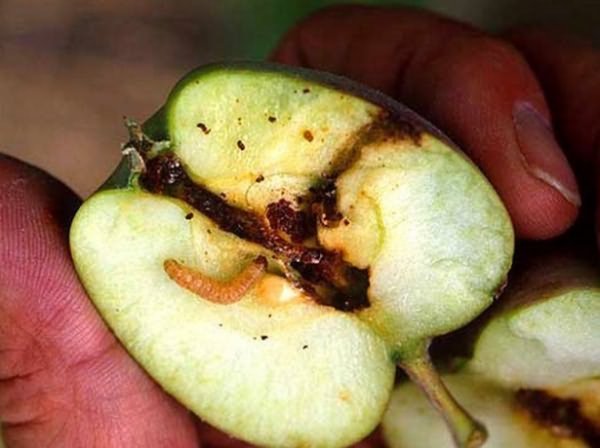
The difficulty is that the caterpillars that have already penetrated the fruit cannot be destroyed, and one butterfly has time to lay more than 100 eggs per season. Therefore, it is necessary to destroy the codling moth in early spring, until the buds are swollen, peeling the dead bark from apple trees and burning it. After flowering and during the fall of excess ovaries, the tree is treated with arsenic-acidic calcium (30 g) mixed with lime (40 g) and water (10 l). Fallen apples are buried deep in the ground, and large fruits suitable for consumption are scalded with boiling water. Also from mid-July, you can use trapping belts for caterpillars, using compote of dried apples, kvass or milk whey as bait.
Apple sawfly
This insect, like the moth, causes the main harm to the fruits, but chooses only the young ovaries, completely devouring their core. Externally, sawflies resemble small bees, up to 7 mm long. The pest overwinters in the ground, the age of adult insects begins five days before the apple trees bloom. Each female sawfly lays up to 80 eggs, placing them one by one in buds, parts of the perianth or in flowers. Appearing yellowish larvae with ten pairs of legs eat mines under the skin of the ovaries, penetrate the fruit and eat the seeds. As a result, the ovaries fall. One larva-larva is able to harm four fruits. The larvae go to wintering a month later after the apple trees have faded.
The apple sawfly remains, as a rule, on the same tree, so there is no need to spray the entire garden with chemicals. It is necessary to fight with adults before flowering of an apple tree, and with larvae after flowering. Spraying is carried out with chlorophos or karbofos. Pupae and larvae are destroyed by loosening the soil under the apple trees. Video about how to save the harvest of apple trees from the moth butterfly
Apple treeworm
Small-looking insects are capable of destroying an entire tree, sucking the sap from it and making it vulnerable to such a dangerous apple disease like black crayfish and to bark beetles. Schmitovki winter in the form of oval small eggs of white color under the brown shield of a dead female. After flowering of apple trees, small yellowish larvae appear from the eggs and spread along the young branches of the apple tree, sticking to the bark. After molting, being in the bark, the larvae become immobile, plunging deep in their proboscis into the tree tissue. Gradually, the larvae become covered with a dense wax-like scute, and a continuous layer of scutes forms on the branches of apple trees. By the end of the summer, the females lay eggs under their scutum and die.
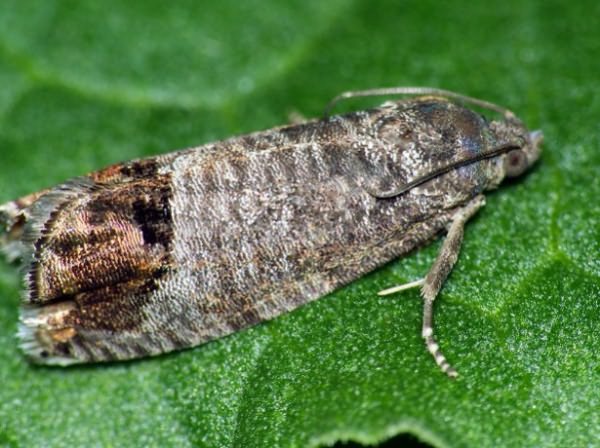
Destroy apple shchitovok at the stage of hatching larvae by spraying with 0.2% karbofosom or metaphosis. To get rid of eggs, trees before blooming buds are treated with 2% nitrophene or 1% preparation of DNOC.
orchardo.ru
Apple Blossom How to deal with apple weevil
Apple Blossom (or, as his name is summer residents, weevil) damages the buds of apple, hawthorn, pear. This is one of the most malicious pests of the fruit garden. The color beetle beetle, belonging to the family of weevils, is up to 5 mm long, gray or brown in color, on elytra with oblique light stripes, with a thin arcuate curved proboscis. Weevil damages not only an apple tree, but also a pear.
Floric - a malicious pest and enemy of the garden
In the presence of a large number of adult weevils in the garden, they destroy up to 100% of the buds, practically depriving the gardener of the crop. Adult apple beetle beetles hibernate in cracks of tree bark, under fallen leaves, in the surface layer of soil under apples and pears.
The exit of beetles occurs with the blooming of buds on fruit trees. Therefore, in the spring, as soon as the air temperature rises to plus 6-8 degrees, the gardener must go out into the garden and inspect the apple trees. Look closely at the kidneys, if you notice that droplets of liquid are slowly flowing out of them, which means that the time has come to fight the pest of the apple tree - the apple-colored beetle.
In the first days, the beetles are not very mobile and are mainly located near the trees around which they wintered. Then weevils crawl onto the branches of the apple tree and make their way along them to the buds. At a temperature of 10 degrees, there is a massive invasion of beetles. For 1-1.5 weeks, they feed on the contents of the kidneys, gnaw their upper cover with their strong jaws, and then, penetrating into the pulp, eat it away. At the same time, droplets of juice protrude from the wounds. This is the so-called "crying kidneys" - sticky drops of juice on the kidneys.
From the moment of budding, when they are still green, flower beetle beetles are actively settling all over the garden, laying eggs in slightly rosy or green buds.
Each female usually lays up to 100 eggs, one in each bud.
The larvae that appeared from the eggs destroy the buds, gnawing everything inside: stamens, pistils, receptacle. The buds damaged by the larvae do not fully bloom, turn brown and dry. Instead of a flower, a brownish cap remains. It seems that the garden is about to bloom, but there is no normal flowering.
If you open such a “cap”, then inside you can always see a worm-like whitish larva or a yellowish pupa, which in 9-11 days will turn into an adult weevil beetle.
Young bugs of the new generation, gnawing round holes in the caps of dried buds, appear after the apple tree blooms during the shedding of excess ovaries. Within 2-3 weeks, a new generation of beetles moves to young leaves and fruits, gnawing holes in them.
In the middle of summer, the beetles hide in different shelters and fall into a state of deep physiological rest, which does not require food, mobility is lost, and breathing is reduced.
Beetles hibernate in shelters, staying at rest until next year. It has been established that 4-10 females on one tree during the budding period destroy an average of 15% of the fruits.
The apple flower beetle does not fly over a long distance and winters in the same garden where it was born, therefore it is at the mercy of the gardener or completely get rid of it within 2-3 years, or “divorce” it in such quantity that it will be necessary to collect some beetles instead of apples.
Measures to combat apple bloom
The most effective measure of the struggle is not to let the weevil into the garden, but beetles are not hares or moles, but also know how to fly, so the gardener must arm himself with a stick (I'm not joking) with insecticides, rakes and a wheelbarrow.
First of all, let's talk about prevention - cleaning the trunks and lower branches of apple and pear trees from the old bark in early spring. Before cleaning under the crown we spread the film and burn the entire bark after harvesting along with the bugs.
In the same early period, traps of wood or glue belts made of straw, burlap, or corrugated paper are placed on the shtambol of a tree under the lower branch. Self-made trap belts are preferably soaked with Carbofos or another insecticide. Immediately after flowering, belt traps are removed and burned.
However, the trapper's belt does not catch all weevil beetles, since they can fly. Therefore, it helps daily shaking off adult beetles on the litter with the beginning of bud break and before the buds are advanced. For shaking off it is convenient to use a long pole (stick) wrapped with a burlap at the end. They sharply hit the branches, and all the collected beetles are destroyed.
If, when shaking off on a litter under an adult tree, you find 5 or more beetle beetles, be sure to sprinkle the trees with insecticide.
Remedies from the flower eater
- Fufanon (10 ml per 10 l of water),
- Malathion (75-90 g per 10 liters of water),
- Inta-C-M (1 tablet per bucket of water).
During the growing season spend 2 spraying. Solution consumption: 2 l per sapling, 5 l per fruiting.
In order to prevent the mass reproduction of the color beetle next year, tear off and burn all the brown and unblown buds.
In the fall, when the garden is badly damaged by a flowering beetle, the fallen leaves are picked and then burned, and the soil is dug up.
If you are in a timely manner to fight with such a pest, like an apple flower beetle, then the harvest in the garden will surely please you.
smoldacha.ru
Apple eatery | Reference Pesticides.ru
Development
Imagospend the winter months in different places, but always near apple trees. An adult individual of the apple beetle can be found in bark cracks on the bole, at a depth of no more than 3 centimeters, near the root collar, in the garden litter, in the forest under wild apple and pear trees. Sometimes insects are also found at some distance from apple trees.
In spring, when the average daily temperature is set around 6 ° C, the weevils begin to wake up. The mass accumulation of insects in the crown of fruit trees is found at the beginning of the growing season with an average daily temperature of 10 ° C. At this time, the apple beetle feeds on swollen flower and leaf buds, as well as buds. Damage is in the form of small holes.
Mating period coincides with the blooming of fruit buds, oviposition - with the phenophase of exposure of apple blossoms. The process continues until the phase of loosening the buds.
With a sufficiently long rostrum, the female gnaws a small hole in the flower bud and lays an egg, placing it between the stamens. The bulk of the eggs is laid in the third decade of April. Some time after this, last year's generation dies off.
Egg. Embryonic development lasts about a week.
Larva. After hatching from the egg, the larva first eats the stamens and then the pistil. Insect excrement contributes to the bonding of the petals of the bud from the inside. As a result, a brown cap is formed, in which the larva first develops, and then the pupa of the apple tree beetle.
The duration of the larval stage of development is 15–20 days. During this time, a significant insect increases in size. The process is accompanied by a double molt and gradual transformation of the larva into the pupa.
Baby doll. The duration of the stage depends on the air temperature. If it varies between 14–18 ° C, then the pupal development will end only after 9–11 days. At a temperature of 22 ° C and above, the developmental period of the pupa is reduced to six days.
Imago. Beetles of a new generation linger in the former bud for a while. As soon as chitinous integuments become stronger, the young people gnaw through the holes and go out. For some time the insects feed on the leaves, gnaw at the windows, and then settle in the garden.
The mass departure of beetles coincides with the phenophase of dropping excess ovary. In the forest-steppe zone, this is the period from the third decade of May to the first decade of June.
The cycle of development of the flowering beetle apple takes about five weeks. By the end of June, the beetles go to the cracks of the bark for summer rest, and after the phenophase, the leaf fall hides for the winter.
Morphologically related species
According to the morphology (appearance) of the imago Anthonomus humeralis Panzer (cherry eater). Adults smaller, first two flagellates of antennae shorter.
In addition to the described species, pear perch (Anthonomus pyri), which is also similar in morphology to adults with apple beetle, is often found.
Related species
Anthonomus pyri Kollar
Geographical distribution
The species range is very wide and fully coincides with the distribution of homemade apple trees. It covers part of Western Europe, then extends further to the east, capturing the entire European part of Russia right up to the Ural Mountains. The northern boundary of the range reaches the latitude of Leningrad, and the southern boundary reaches the Caucasus. In the east, the apple beetle is found in the Primorsky Territory, on the Japanese islands and the Korean Peninsula.
Harmfulness
In the period of mass outbreaks of reproduction, the apple-colored flowering beetle can lead to significant damage to fruit trees and the death of the entire crop. We will feel damage from this pest in the years of weak flowering.
Economic threshold of harmfulness. For the flowering apple tree, this indicator is expressed in the presence of 20–40 beetles on a tree in the phenophase of a green cone or damage to 15% of the buds in the same phase of plant development.
Wrestling
Timely and competently carried out agrotechnical measures significantly increase the resistance of plants to damage by the tsvetnoy apple. The agrotechnical measures of struggle include, first of all, the right choice of a place to lay a garden - away from wild fruit trees. Timely care in the form of loosening tree trunks, destruction of fallen leaves, removal of diseased and dry branches leads to a significant reduction in the number of the pest.
Mechanical way- direct destruction of insects. In the case of the tsvetouplo apple, this is shaking off the beetles from the crown of the tree onto a previously spread thick material (tarpaulin or synthetic film). It is advisable to hold this event in the morning when insects leave the state of winter dormancy at air temperatures below 10 ° C. Before flowering trees, 3-4 shaking off procedures are recommended.
Trap method. In early spring, at the base of the trunk, trap belts are laid out of straw and other materials, dusting with insecticidal powders. Remove this belt only after flowering.
Used as a trap and glue belts. They are attached directly to the trunk of a tree. Weevil cannot overcome such a barrier and perishes from lack of food.
Chemical method, despite some negative factors, it is still considered the most effective. For the destruction of the apple tree beetle, spraying the crowns and tree trunks with biological pesticides, pyrethroids, neonicotinoids, and organophosphorus compounds are used.
Apanteles (Apanteles spurius (Wesm)) is especially effective. It has been established that in some years up to 90% of the larvae were affected.
pesticidy.ru
MEMO ON THE FIGHT AGAINST APPLET FLOWERS
MEMO ON THE FIGHT AGAINST APPLET FLOWERS
The basic rules of conduct when meeting with apple tsvetoedom.
The apple-flowered beetle (Anthonomus pomorum) is a small beetle up to 5 mm long, with a characteristic appearance of a weevil, has a dark brown color. The only fodder plant is an apple tree, extremely rarely the beetle is found on a pear tree.
WHEN DO THE BUGS APPEAR AND HAVE BEEN LEADING?
In early spring, at a temperature of 6˚, beetles emerge from wintering, and when warming to 10˚, they begin to actively crawl and feed on buds that have not yet blossomed. When the buds begin to advance, the females lay one egg in each bud. They are placed between the stamens. One female can lay up to 100 eggs! From each hatch a larva that feeds inside the bud and eventually pupates. It usually takes two to three weeks. All affected buds dry out.
The pupae stage depends on the air temperature. If it fluctuates within 14–18˚, then the development of the pupa is pumped in 9–11 days. At a temperature of 22˚ and higher, the developmental period of the pupa can be reduced to six days. Beetles emerged from the pupae gnaw holes, come out of the bud and feed on young leaves. The summer heat is not long-lasting for bugs, in July they finish eating and hide under the bark. They wait until autumn, and then go under the fallen leaves and in the hollows for wintering.
Important. As soon as the buds on the apple trees swell, begin to examine them regularly. If the juice drips from them, then the flowering eater has begun its activity.
In the fight against apple flowering beetles, the main thing is to apply the drug before the beetles lay their eggs inside the buds, because after that the pest becomes invulnerable. In the future, an insignificant death of the pest can be obtained only during the hatching of the larvae, when some of them may be located near the surface of the buds.
How not to be late? As soon as the buds on the apple trees swell, begin to examine them regularly. If the juice drips from them, then the flowering eater has begun its activity. At the slightest suspicion, spread a tarp under the apple trees and shake them well. If the trees are attacked by a flower beetle, adult insects will definitely fall. They need to be destroyed, and the trees sprayed.
When the air temperature at the time of treatment is more than 18–20˚, it is better to choose the preparation of biological origin “Fitoverm”. In experiments on the apple, "Fitoverm" ensured a 95–100% death of the beetle-bearing beetle beetles. To achieve greater preservation of the drug on plants, use adhesives, preferably also of biological origin. At a temperature of less than 18˚, it is worth spraying with Kinmiks or Fufanon Nova.
Despite the fact that spraying is the most effective method of killing an apple flower beetle, you should not discount agricultural equipment.
We process natural circles
No longer tolerate time: you need to loosen, and in some places and digging the soil under the trees, starting with apple and pear. This is done as early as possible in the readiness of the land in order to strike at pests that hibernate in the soil, such as weevils, tsvetoedy. If you destroy the cracks in the soil, which pests deepened for the winter, there will be hope that some of them will not be able to get out.
The wider we create a loosened tree trunk, the better the tree will be, as this is a blow to the weeds. We will make the circle wider than the crown projection.
After the fruit trees (let's not forget the cherry, the plum), the second number is raspberry - it is also badly damaged by the tsvetnoy. Loosening raspberries - a useful technique, but very few people do it.
Timely care of apple trees - loosening tree trunks, destroying fallen leaves, phytosanitary pruning - can reduce the number of pests so much that it will not come to processing. The economic threshold of harmfulness, above which treatment becomes necessary, is 20–40 beetles on the tree beetle on the tree in the green cone phenophase or damage to 15% of the buds in the same phase of plant development.
Do not forget about the birds, get ready for their arrival, hang out birdhouses, titmouse. Insectivorous birds greatly help to reduce the number of apple tsvetoeda and other pests without any additional measures.
Irina Ivanova, sotki.ru
The most suitable moment for the colonization of flower buds
Posted by: Olga Filippova on April 27, 2015, 21:03:08
Http://zakustom.com/blog/43675873952/Pamyatka-po-b...rtesen.ru&paid=1&pad=1
How to save apple trees from a nasty flower beetle?In 2003, we got an old apple orchard. Everyone in the area had a good harvest of apples, and our apple trees did not even bloom.
I asked both neighbors and summer residents:
- What to do?
In reply:
- Spray.
- And when?
- Yeah right now"
- What?
- “Karbofos” ...
Such a non-explanatory conversation took place in June 2003. And I followed the advice of the guard (and how could it be otherwise) and sprayed the apple trees with Karbofos.
But the result is zero. Intuition told me that I had done wrong. After all, it is necessary to first diagnose your apple trees, and then start treatment.
How I was right!
Having dug headlong into the relevant literature, I carefully compared the apple trees in the pictures in the books and my own in the garden: leaves, twigs, buds, if they came across. Frankly, I did not find the answer immediately, but only the next year, when instead of a pink bud, I found closed dried petals, but under them a hidden yellow larva, which looked like a small caterpillar (5 mm in length) in the shape of the letter “C” and with a black head.
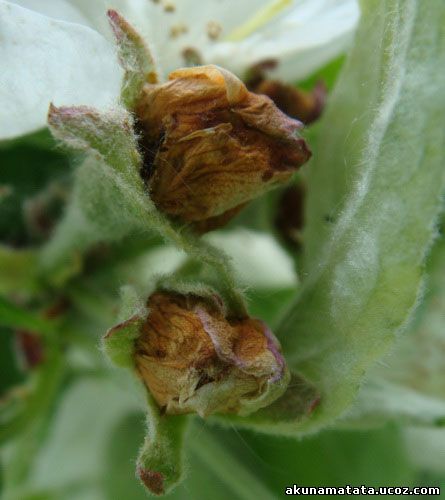
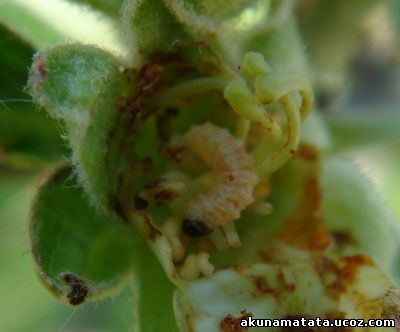
It was larva of the beetle. The beetle itself is dark gray or black in color, about 5 mm long, with a characteristic long proboscis.
He is called so WEEVIL (for his long nose) or COLORED for the fact that he lays the larva in more small buds, and there the larva grows, feeding on the future flower.
Weevil (flower beetle) although it can fly, but prefers to crawl. Under favorable conditions for this beetle, it can strike up to 100% of apple flowers with its larvae. As a result, the apple tree does not even bloom, and as a result, the harvest does not have to wait. The flower eater also spreads over pears, but it affects pears significantly less (up to 50%). Still, his favorite place for laying larvae - flowers of apple.
By the way, I noticed that not every cultivar of apple trees is suitable for a flower to taste. One apple tree (I don’t know, unfortunately, the name of its variety, as it was planted a long time ago), it did not favor and hit only 50% of flowers on it. While the flowers on the next apple tree hit everything completely. Wow? Bug, and also has a gastronomic addictions)))
In central Russia (Nechernozemie) the most active time of the beetle COLOR FOOD have to at the end of April - the beginning of May. AND during this period it is necessary to spray the apple (and pear) garden !!! However, the weather can make its own adjustments - spring can be early or, on the contrary, late. Therefore, it is better to navigate not according to the calendar, but according to the appearance of the buds of the apple. At the apple tree (and pear) determine the 12 phases of the state of the kidneys:
1. Kidney alone
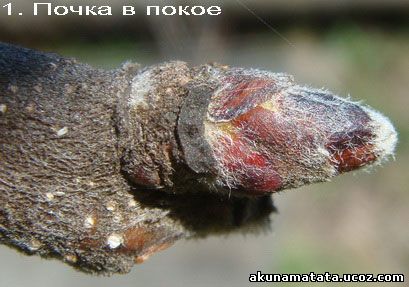
2. Kidney swelling
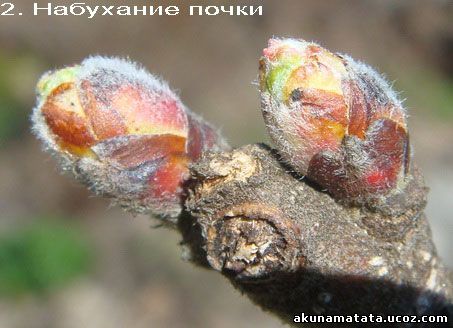
3. "Green Cone"
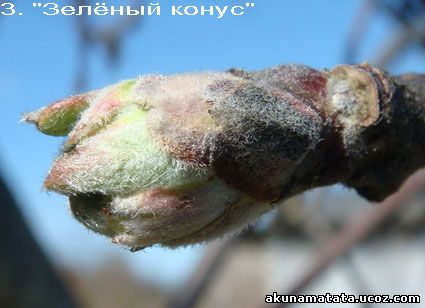
4. "Mouse ear"

5. Green Kidney
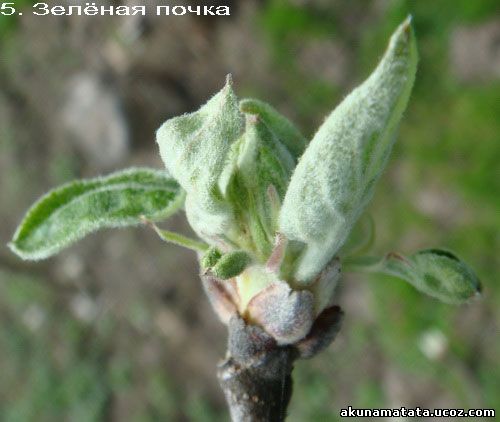
6. The isolation of buds
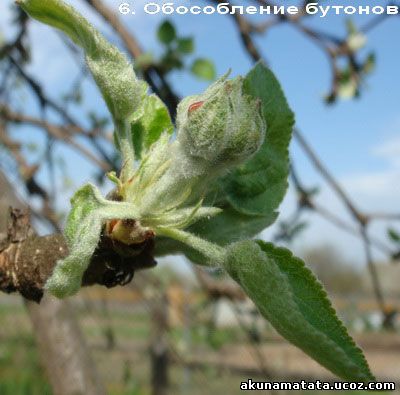
7. Rose bud
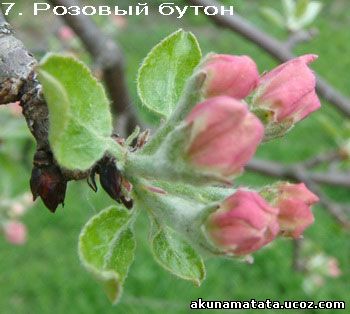
8. Flowering
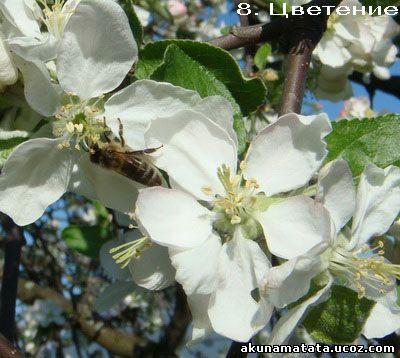
9. Falling petals
![]()
10. Growth of the ovary
11. Fruit Growth
12. Crop ripening
It is very important to correctly determine the processing time of the trees against the COLORING TOWER, an error of more than 5 days may not give any results or be harmful at all. Checked in person!
To fight with COLOR FOOD, you have to wait Phase 3 Green Cone and during this period spraying (inclusive up to the 4th “Mouse ear” phase).
It should be on the check, because these phases fly quickly literally in 5 days (plus or minus 1-2 days depending on the weather).
And what to spray?
I prefer "Decis" (dilute 2 ml of the drug in 10 liters of water). It is good to alternate drugs, i.e. in this year, apply, for example, “Decis”, and in the following year another type of contact drug, for example, “Kinmiks”, and a year later again “Decis”. And alternate.
Spray preferably at least three to four hours before the rain and at the same time abundantly moisten the crowns of trees.
In my garden, it is enough for me to cultivate apple trees once in the period from the 3rd phase (“Green cone”) to the 4th (“Mouse ear”). Of course, it does not happen that all the buds on all apple trees look the same. Therefore, I see that most of the kidneys are in the 3rd phase of the Green Cone, and some of the kidneys are already in the 4th phase of the Mouse's Ear.
If everything is done on time and correctly, then in May the apple-trees will stand as if they were poured with milk. Like these ones:
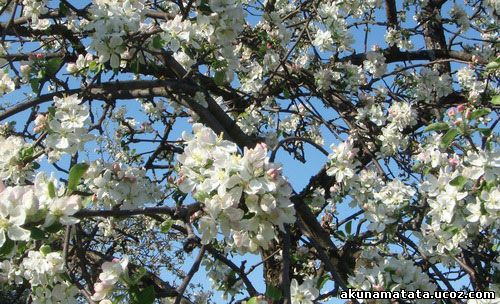
Useful video - What does a tsvetoyod
Apple flower beater is a formidable enemy of your garden
Http://akunamatatalife.com/publ/garden_and_flowers/insect/cvetoed_ili_dolgonosik/11-1-0-37

